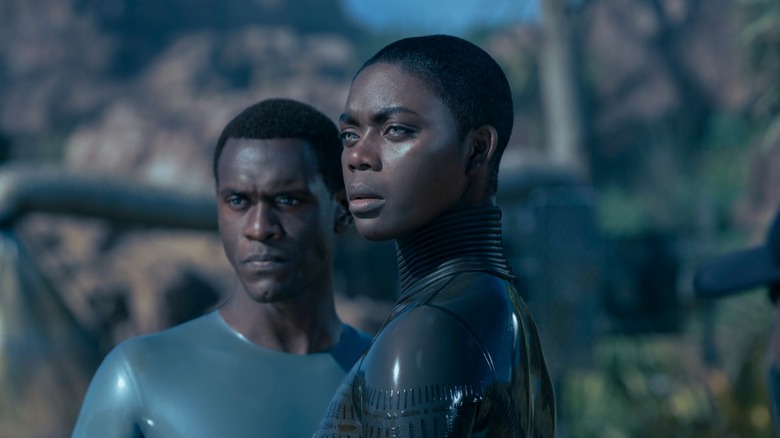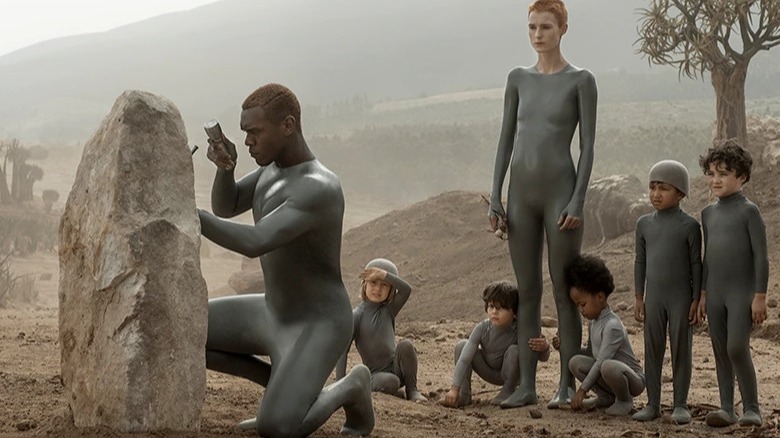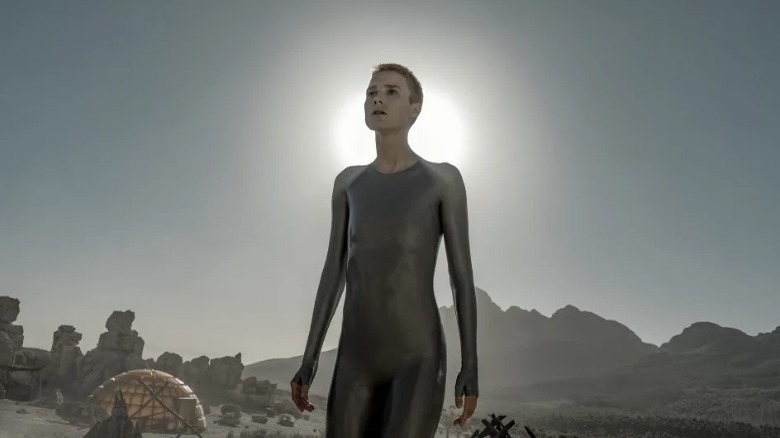Ridley Scott Went Low-Tech To Sell The Reality Of Raised By Wolves
The dystopian sci-fi series "Raised by Wolves" was a collaborative effort by series creator Aaron Guzikowski and executive producer Ridley Scott, and the latter was heavily involved in the process of creating the look and feel of the show. Exploring android-human relations is not new territory for Scott, as the director has etched detailed, futuristic landscapes in his "Blade Runner" and "Alien," while "Prometheus" and "Alien: Covenant" dived deeper into android psyche with Michael Fassbender's David 8/Walter. Scott and Guzikowski take the concepts further in "Raised by Wolves," in which two androids arrive on an alien planet to create an atheistic colony with the aid of human embryos, facing many threats in the process.
The premise of "Raised by Wolves" puts reprogrammed androids in the spotlight, as they are solely responsible for securing the future of the human race on an unknown planet named Kepler-22b. To sell the premise convincingly, Scott and his team had to make sure the world of "Raised by Wolves" was one that was completely fresh and alien to viewers, while making sure it retained a human touch as the story progressed. Series cinematographer Ross Emery, who worked on five episodes in the first season, explained this was achieved by keeping things as low-tech as possible, as opposed to a lofty, visual approach.
There are various facets to how Scott and Emery achieved the aesthetic, which Emery explains in considerable detail.
Building a realistic, dystopian future
Ross Emery had previously collaborated with Scott on "Alien" and "Gladiator," making him well-versed with the director's approach to creating worlds that were distinctly different from our own. For "Raised by Wolves," RidleyScott's vision was to put androids in the driving seat as they battle the threats of a religious extremist group called the Mithraic, along with the hidden threats of a seemingly habitable planet. In an interview with ibc.org, Emery explained that Scott wished to create "a futuristic world where technology is unrecognizable to people" watching the show, as its events unfurl in the distant future — sometime in the 22nd century.
Elaborating on this further, Emery said Scott urged props, wardrobe, and production designers to keep the unique world of the show in mind, as everything that graced the screen would have to be backed by a convincing backstory. This meant reworking any piece of technology that looked "noticeably familiar from our world" and using a ton of "artificial light sources ... and organic plasmas" to make the lighting on Kepler-22b as naturally compelling as possible.
As the androids on Kepler-22b are in survival mode and focused on populating the planet with humans, their day-to-day activities need to look as organic as possible, coupled with a "show-don't-tell" aspect of limited technology during an all-out dystopian war. Even the name of the desert planet, Kepler-22b, is based on a real-life exoplanet of the same name, which is believed to be "in the most habitable zone" for human survival (as of yet) by NASA. This dedication to grounded realism and world-building, among other qualities, helped "Raised by Wolves" emerge as a compelling entry in the sci-fi genre.
How low-tech cinematography elevated the story
A high-concept sci-fi premise is often propped up with the help of expensive, high-tech camerawork and filming formats, but Ridley Scott and Ross Emery took the exact opposite route when it came to "Raised by Wolves." In the same interview, Emery explained the importance of imparting a "human touch" to the show's world and characters, achieved with the aid of controlled camerawork and low-tech captures that worked well with the narrative. This also worked in favor of capturing authentic performances from the child actors, who were able to inhabit their roles freely without being hyperaware about camera placements.
According to Emery, cinematographic simplicity was the key to unlocking the essence of "Raised by Wolves," as something too intricate or complex would have hindered flexibility in post-production. Moreover, a VR rig was used to capture the altered worldview of the androids, which offered a new point of view and created ample space for experimentation with something fresh. This decision worked in favor of the android characters, as it helps us better understand their daily approach to concepts like memory, compartmentalization, and the processing of everyday emotions.
Apart from this, the choice of shooting in a remote desert in Cape Town, South Africa, helped capture the intended aesthetic for Kepler-22b. Scenes were shot against a painted backdrop to manage VFX costs, and the overall budget and allowed Scott to tinker with scenes in post as deemed necessary. Keeping the visual aspects reined in while not compromising on creativity led to a beautiful yet terrifying setting for the show, which ultimately paid off for Scott and Guzikowski in the end.


